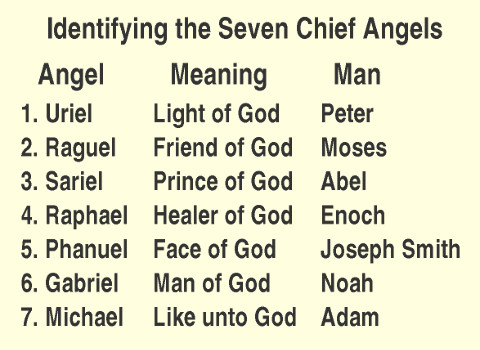
by John P. Pratt
18 Jan 2020, Eagle (S), Wisdom (US)
©2020 by John P. Pratt. All rights Reserved.
|
1. Seven Chief Angels 2. Priesthood Restored 2.1 John the Baptist 2.2 Peter, James, John 2.3 Elias & Elijah 3. Aaron 4. Melchizedek 5. Conclusion Notes |
The concept of multiple mortal probations[1] suggests the probability that the seven chief angels have lived as mortals on earth more than one time each. This is the second article in a series which proposes possible correlations between those seven angels, various religious leaders and constellations that might represent them. The first article proposed that in the 7x7 table of 49 constellations, each column represents one of the seven angels and the seven constellations in each column may each represent one of their the mortal lives. Moreover, it went on to identify which constellation represented what formerly was considered to have been the only mortal life of each angel (see Table 1).[2]
 |
It is recommended that all three of those referenced articles be read prior to this one because it builds on all of them. This is all very new material which requires study and deep pondering to understand and accept.
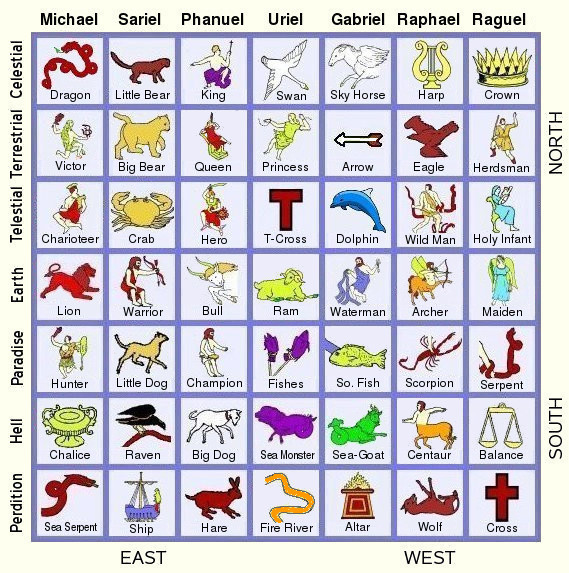 |
Figure 1 shows the 7x7 table of 49 constellations, with the name of one of the seven chief angels at the head of each column. This table is actually a map of the heavens as seen from the northern hemisphere looking south. Thus it has the compass directions listed on the right and bottom. Moreover, each row represents a level of spirituality, with the top rows being the most spiritual or heavenly.
Now let us continue identifying just which constellations likely represent those angelic men who restored various priesthood levels to Joseph and Oliver.
The first article in this series proposed one constellation in each column to have represented the life of each of the angels, being the life already identified for that angel. Figure 2 shows the same table without the names of the constellations, which hopefully the reader has memorized by now, and in the place of those names are the names of the first seven mortal men who were one mortal probation of each of those angels. It is the probation which was formerly thought to have been the only mortal life of the angel.
 |
Section 1 was a review of the first article in this series. Now we turn to identifying six more constellations associated with important priesthood bearers.
Let us now proceed to propose constellations to represent those angels who restored the various levels of priesthood.
The Aaronic Priesthood is the lowest level of priesthood. It was restored to Joseph Smith and Oliver Cowdery in May 1829 by an angel who identified himself as having been called "John the Baptist" during life. The purpose of this section is to identify both his angel name (what column his constellation is in) and also his constellation (what row it is in).
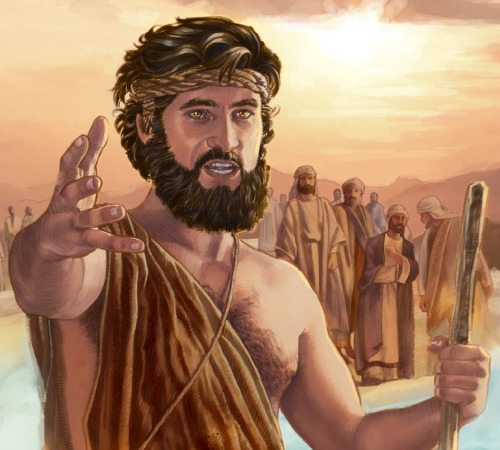 |
That amazing endorsement alone is a strong vote in favor of John the Baptist being Michael, the greatest of the chief angels, called the archangel.
Secondly, at the same time, Jesus announced that John the Baptist was the fulfillment of Malachi's prophecy that the Lord would send His messenger to prepare the way of the Lord (Mal. 3:1). That scripture is nearly always associated with the Second Coming because the next verses ask who can abide the day of His coming, which will be like a refiner's fire. Moreover, after talking more about that day which shall burn as an oven, Malachi repeats that before that day, the Lord will send the prophet Elijah. Thus, the usual interpretation of this scripture is that it refers to the coming of Elijah before the Second Coming.
So was Jesus mixed up? Did He not understand the difference between His first and second comings? Of course not, so we should take what he said seriously.
His apostles asked him a very similar question when Elijah appeared to them on the Mount of Transfiguration. They asked why the scribes (quoting Malachi) said that Elijah would come first and yet he appeared to come after Christ on the mount. Of course, they were referring only to His first coming. Jesus replied that indeed Elijah ("Elias" in KJV Bible) had come first, implying he referred to John the Baptist (Mat. 17:10-13).
 |
A final clue is that when Jesus quoted Malachi's prophecy, he referred to the angel to precede His coming as "my messenger" (Mal. 3:1). That possessive pronoun "my" in "my messenger" may indicate the personal angel of the Lord, who is Michael.
Thus, putting all of this together that everything about John the Baptist seems to be the greatest, it is suggested that he was an incarnation of the archangel Michael.
As will mentioned above, the top row of the table which is for the most celestial lives, appears to be reserved mostly for great prophetic writers such as Isaiah. If John the Baptist is the greatest, then he is deserving to be in that row. Thus, it is suggested that his constellation is the Dragon (Draco). The Dragon, Serpent, and Scorpion can refer to either good or evil beings, depending on the context. In this context, it refers to God, being located in the first position at the top of the heavens. Michael means "Like unto God", so the Dragon as one his constellations is indeed like unto God.
The star days at the birth and martyrdom of John the Baptist support this identification of the Dragon constellation. The star day of his birth on the Unified Star Calendar was of the star Power Center in the Dragon (Zeta Dra), which is the very nearest star to the symbolic throne of God (the ecliptic pole). Moreover, the day was the day "Prophet", which is in the Serpent (Serpens, being the star Alpha Ser) on both of the Star Calenars (S, US). Those are three witnesses that the choice is correct.
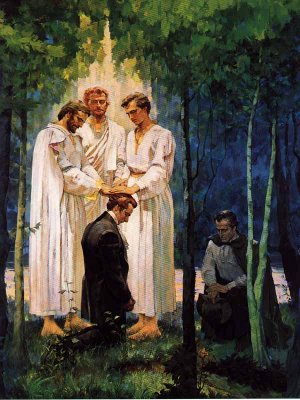 |
The constellation for Peter was already proposed in the last article to be The Fishes, as shown in Figure 2. Let us now identify the constellations for James and John.
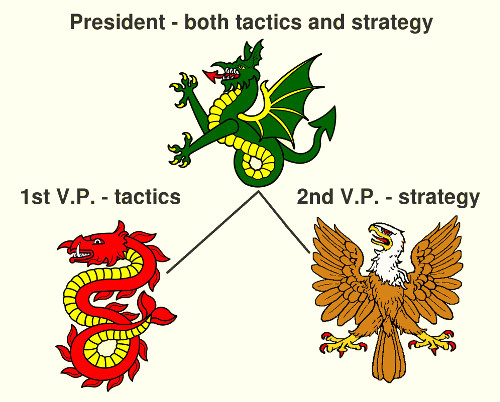 |
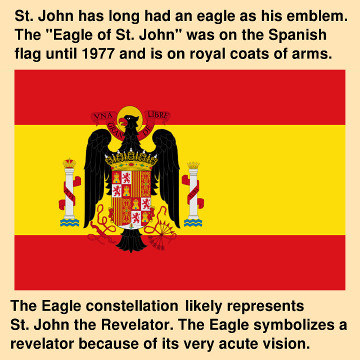 |
James would be the counterpart of the Eagle, namely, the Serpent, the symbol of a prophet, who feels rather than sees. In this article it was already noted that John the Baptist died on the star day Prophet on both star calendars, which is the star in the head of the Serpent. Thus, it is proposed that the Serpent (Serpens), being held by the Serpent Bearer, also called Healer, (Ophiuchus) is the constellation representing James. The Serpent is always considered a separate constellation from the Serpent Bearer.
In the Kirtland Temple on Easter Sunday, 3 Apr 1836, Moses, Elias, and Elijah each appeared in succession. They restored the fulness of the priesthood, which apparently must be done in a qualified temple.
The constellation for Moses has already been identified as the Herdsman (Bootes). It is not known to me who "Elias" was, except that it was likely a code name or title for Noah. If that is the case, then his constellation has also been identified as the Southern Fish. But what about Elijah? What constellation is his?
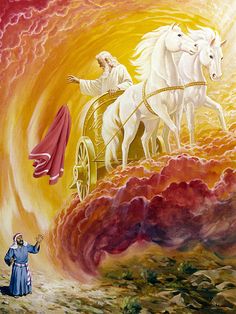 |
Another consideration might be the Raven because Elijah was once fed by ravens, but one problem with that is that it is in the wrong column. That is, Elijah and John the Baptist are the same angel and hence in the same column. Moreover, there is an excellent confirmation that the Charioteer is the correct constellation.
One stunning confirmation of Elijah's constellation comes from the star on which the unborn baby, who would be John the Baptist, leaped in the womb of his mother Elizabeth. The proposed day for that occurred on the star day of Glory (Capella), the brightest star in the Charioteer and one of the brightest in the sky. That event symbolized the day of Quickening when the spirit enters the womb. Until now it has been confusing as to why that bright star would be associated with John the Baptist, and not on his day of birth, but at quickening.
Now in the light of our beginning to understand multiple probations, the symbolism is clear. That was the day that the spirit of Elijah the Charioteer entered the body to become John the Baptist!
What about Aaron? If he is an important enough religious figure to name an entire of priesthood after, then shouldn't he also be represented by a constellation?
 |
When a possible constellation for Aaron is sought among Uriel's row, there is one candidate which fits an important event in Aaron's life. When a rod from a man from each tribe of Israel was taken, from which to choose one to head the priesthood, it was found that the rod of Aaron from the tribe of Levi had blossomed and even had borne fruit (Num. 17:8). Moreover, it was Aaron who cast the rod down which turned into a serpent (Exo. 7:10). He was not still alive when the brazen serpent was put on the pole, in similitude of the Crucifixion, so that is not a factor.
One of the constellations is the the T-Cross (Triangulum), which is mostly significant of the pole on which the Savior would be crucified. But that is the significance in the life of Jesus, not Aaron. In his life, it could well represent the "rod of Aaron", which was a significant emblem of his power. It was Aaron who lifted his staff over the Nile to turn it to blood (Ex. 7:19) and also to bring forth frogs (Exo. 8:5). The pole of the T-Cross could be the rod of Aaron and the cross bar at the top could represent the budding and blossoming. Thus, it is proposed that the T-Cross represents Aaron.
 |
The name "Sariel" means "Prince of God". Melchizedek was known as the "Prince of Peace" (Alma 13:18). Being called a "Prince" is a clue to what column Melchizedek should be found in. The name "Sariel" means "Prince of God", so that is a vote for Sariel's column.
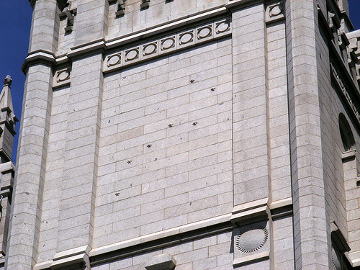 |
A birth star is one way to tie an event during the life of one of these leaders to his constellation, and in this case it is about all that is available. Thus, it is proposed that the Great Bear (Ursa Major), which represents priesthood leaders, is the constellation of Shem/Melchizedek.
There is also a confirmation of this connection of Melchizedek to Abel. In the great revelaton on the Melchizedek Priesthood known as D&C 84 in the LDS Church, the Lord reveals that Melchizedek could trace his priesthood back to Abel (D&C 84:16), rather than Adam's son Seth who replaced him. That is really a curious little detail for the Lord to mention. Why would that be important? It now appears that the line through Seth would be the higher Patriarchal Priesthood. If the proposal of this section is correct, it would mean that Abel's priesthood was carried on down not only to his descendant, but to another mortal probation of his spirit, that of Sariel, the Prince of God, who would become the great king and high priest Melchizedek, the Prince of Peace.
This article is the second in a series which attempts to identify constellations which represent one of the mortal lives of some of the seven chief angels where they were great priesthood leaders, or were one of those who returned to restore needed priesthood to Joseph Smith and Oliver Cowdery.
By following the requirement that something during the mortal life should tie in some way to the constellation, six new constellations were added to the previously found seven, for a total of thirteen so far. The six are as follows: John the Baptist is the Dragon (Draco), Elijah is the Charioteer (Auriga), Melchizedek is the Big Bear (Ursa Major), Aaron is the T-Cross (Triangulum), John is the Eagle (Aquila) and James is the Serpent (Serpens). These new additions are shown in red in Figure 3.
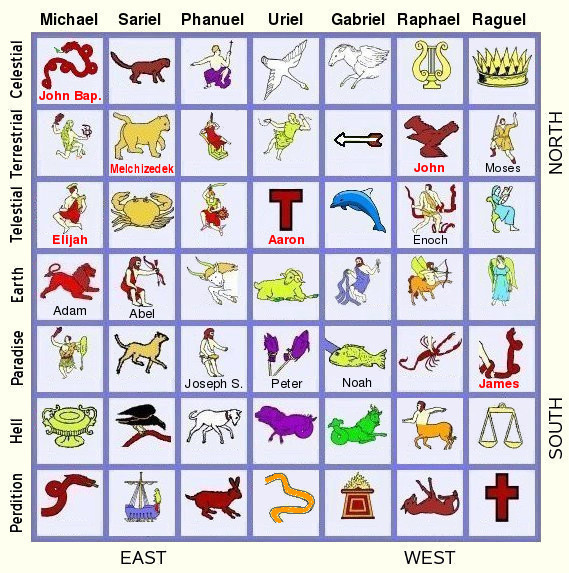 |
These constellations were truly inspired when revealed long ago to Enoch the Prophet by the angel Uriel. They help us to understand the foreknowledge and depth of the plan of salvation provided for us by a loving God.